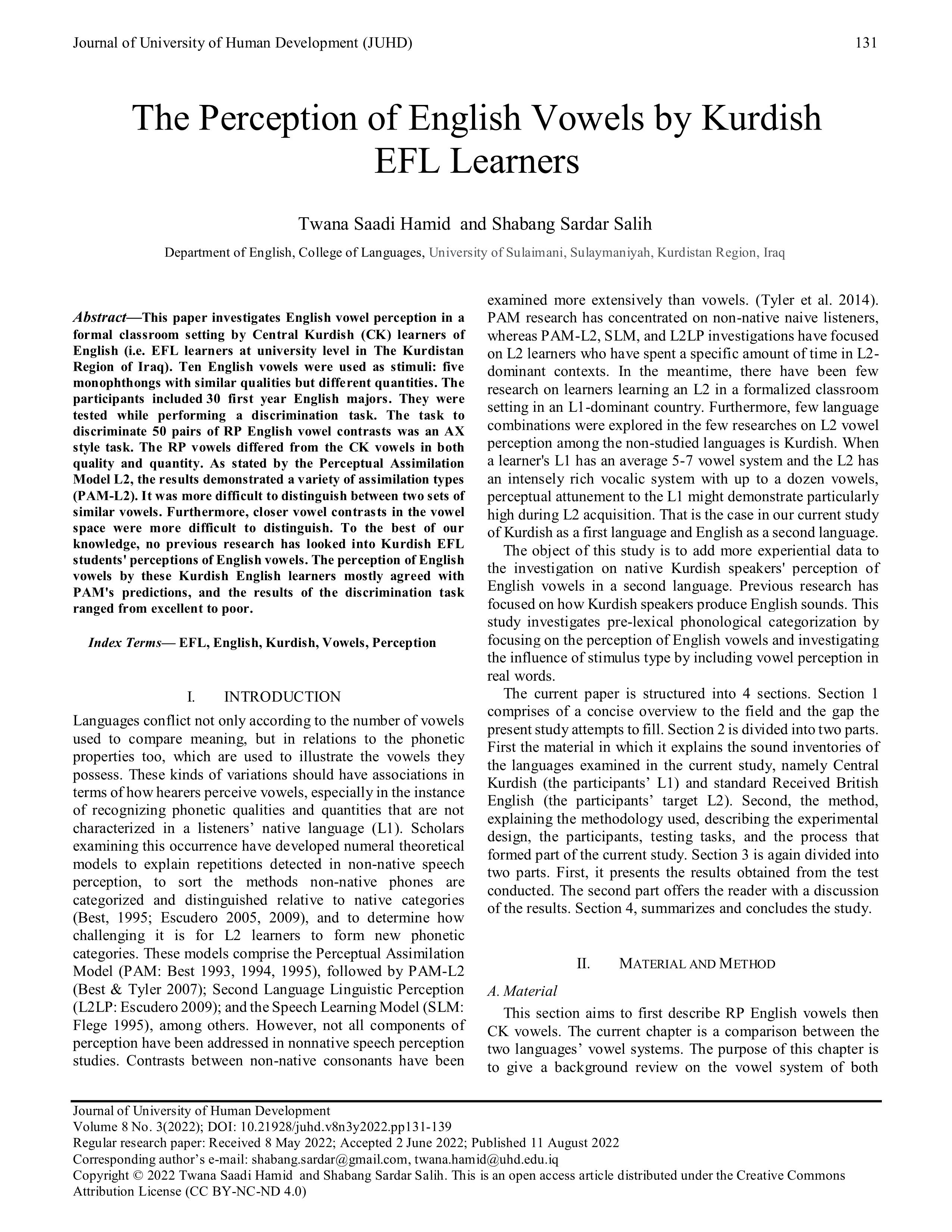The Perception of English Vowels by Kurdish EFL Learners
DOI:
https://doi.org/10.21928/juhd.v8n3y2022.pp131-139Keywords:
EFL, English, Kurdish, Vowels, PerceptionAbstract
This paper investigates English vowel perception in a formal classroom setting by Central Kurdish (CK) learners of English (i.e. EFL learners at university level in The Kurdistan Region of Iraq). Ten English vowels were used as stimuli: five monophthongs with similar qualities but different quantities. The participants included 30 first year English majors. They were tested while performing a discrimination task. The task to discriminate 50 pairs of RP English vowel contrasts was an AX style task. The RP vowels differed from the CK vowels in both quality and quantity. As stated by the Perceptual Assimilation Model L2, the results demonstrated a variety of assimilation types (PAM-L2). It was more difficult to distinguish between two sets of similar vowels. Furthermore, closer vowel contrasts in the vowel space were more difficult to distinguish. To the best of our knowledge, no previous research has looked into Kurdish EFL students' perceptions of English vowels. The perception of English vowels by these Kurdish English learners mostly agreed with PAM's predictions, and the results of the discrimination task ranged from excellent to poor.
References
Amin, W. O. (1979). Aspects of the verbal construction in Kurdish. M. Phil.
Ahmad, A. R. (1986). The phonemic system of modern standard Kurdish. PhD thesis, University of Michigan.
Best, C. T. (1993). Emergence of language-specific constraints in perception of non-native speech: A window on early phonological development. In Developmental Neurocognition: Speech and face processing in the first year of life Springer, Dordrecht. (pp. 289-304).
Best, C. T. (1994). The emergence of language-specific phonemic influences in infant speech perception. The development of speech perception, (pp.167-224).
Best, C. T. (1995). Learning to perceive the sound pattern of English. Advances in infancy research, 9, (pp. 217-217).
Best, C. T., & Tyler, M. D. (2007). Nonnative and second-language speech. Language experience in second language speech learning: In honor of James Emil Flege, (pp. 13-34).
Crothers, J. (1978) Typology and universals in vowel systems. In Universals of human language, (J. H. Greenberg, C. A. Ferguson & E. A. Moravcsik, editors). Stanford: Stanford University Press (pp. 93–152).
Cruttenden, A. (2008). Gimson’s Pronunciation of English, 7th edition, London: Hodder Education.
Deterding, D. (2006). The North Wind versus a Wolf: short texts for the description and measurement of English pronunciation. Journal of the International Phonetic Association (pp. 36, 187–196).
Escudero, P. (2005). Linguistic perception and second language acquisition: Explaining the attainment of optimal phonological categorization. Netherlands Graduate School of Linguistics.
Escudero, P. (2009). Linguistic perception of “similar” L2 sounds. Berlin: Mouton de Gruyter, (pp. 151-190).
Flege, J. E. (1995). Second language speech learning: Theory, findings, and problems. Speech perception and linguistic experience: Issues in cross-language research, (pp. 92, 233-277).
Hawkins, S. & Midgley, J. (2005). Formant frequencies of RP monophthongs in four age groups of speakers. Journal of the International Phonetic Association, (pp. 35, 183–200).
Harrington, J. (2010). Acoustic phonetics. In: The Handbook of Phonetic Sciences, 2nd edition, W.J. Hardcastle, J. Laver, and F. Gibbon (eds.), Malden, MA: Wiley‐Blackwell, (pp. 81–129)
Haig, G. and Ergin Ö. (2015). Kurmanji Kurdish in Turkey: structure, varieties and status. Unpublished poster presentation at: Linguistic Minorities in Turkey and Turkic speaking minorities of the peripheries, November 2015, Weisbaden, Germany.
Hamid, T. (2015). The prosodic phonology of central Kurdish. PhD thesis, Newcastle University.
Jakobson, R., Fant, G. and Halle, Morris (1952). Preliminaries to speech analysis. Cambridge: MIT Press.
McCarus, Ernest N. (1958). A Kurdish Grammar: Descriptive Analysis of the Kurdish of Sulaimaniya, Iraq. New York: American Council of Learned Societies.
Mackenzie, D. N. (1961). Kurdish Dialect Studies I. London: Oxford University Press.
Mackenzie, D. N. (1962). Kurdish Dialect Studies II. London: Oxford University Press.
Maddieson, I., & Disner, S. F. (1984). Patterns of sounds. Cambridge University Press.
McCarus, E. N. (1997). Kurdish Phonology. In: Alan S. Kaye, ed. Phonologies of Asia and Africa: Including the Caucasus Vol. 1. Indiana: Eisenbrauns. (pp. 691-706).
Mahwi, M. (2008). fônatîk u fônôlôžî: fônatik. Slemani: University of Sulaimani.
Mirzaei, K., Gowhary, H., Azizifar, A., & Esmaeili, Z. (2015). Comparing the phonological performance of Kurdish and Persian EFL learners in pronunciation of English vowels. Procedia-Social and Behavioral Sciences, (pp. 199, 387-393).
Lass, R. (1984). Phonology: An Introduction to basic concepts. Cambridge: Cambridge University Press.
Peterson, G. E., & Lehiste, I. (1960). Duration of syllable nuclei in English. The Journal of the Acoustical Society of America, (pp. 32, 693-703).
Roach, P. (2009). English Phonetics and Phonology: A Practical Course, 4th edition, Cambridge: Cambridge University Press.
Stevens, K. N., & House, A. S. (1955). Development of a quantitative description of vowel articulation. Journal of the Acoustical Society of America, (pp.27, 484–493).
Tyler, M. D., Best, C. T., Faber, A., & Levitt, A. G. (2014). Perceptual assimilation and discrimination of non-native vowel contrasts. Phonetica, (pp. 71, 4-21).

Downloads
Published
How to Cite
Issue
Section
License
Copyright (c) 2022 Twana Saadi Hamid , Shabang Sardar Salih

This work is licensed under a Creative Commons Attribution-NonCommercial-NoDerivatives 4.0 International License.


